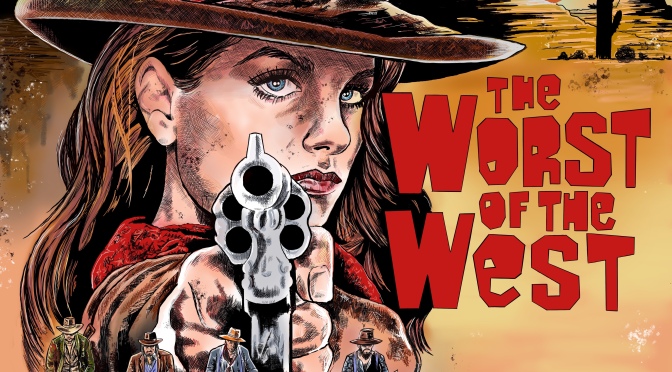Though we may never see the lost Western from enigmatic American filmmaker Gene Jugan, The Worst of the West remains one of the most culturally impactful films of its era despite being largely unheralded as such. For decades the mythical project lived only in the memories of those lucky few enlisted for the ill-fated production in early 1969, along with a single surviving storyboard image of Josephine, the film’s heroine. Films rarely survive in the public consciousness with so little evidence of existence, and many with more have been forgotten. But those films were not created by Jugan, the most inscrutable and territorial auteur of his era and, possibly, the most brilliant.
Now, following the biggest breakthrough to date in the unending search for Jugan’s swan song, here is everything we know about The Worst of the West:
According to Peter Tirico — Jugan’s longtime friend, frequent script collaborator, and author of the 1999 biography Jugan — the first kernel of The Worst of the West may have been planted in Jugan’s mind in Chicago in 1965 when he first saw Sam Peckinpah’s epic Western Major Dundee. “Spurred by the idea of Moby-Dick in the West,” Tirico writes, “Jugan intended to return home to his Woodlawn apartment to outline his first Western film. But he only made it as far as Baxter’s on East 47th, where The Worst of the West was born on the back of a drink coaster.”

To this point Jugan was known primarily for the Lee Marvin crime drama The Pick-Up (1961) and the WWII adventure Hellcats (1964), both of which were critically well-received but failures at the box office. Studios balked at the risky prospect of funding another big-budget project with Jugan at the helm, particularly a genre film. Finally, Italian producer Pasquale Ferzetti pledged majority funding if Jugan agreed to shoot in Europe, and with that The Worst of the West became a reality. Jugan quickly assembled a cast and crew and began shooting in January of 1969, intending the film to be released late that same year.

Problems arose immediately. Claudia Stanton, the actress cast to portray the protagonist Josephine, contracted the flu and was forced to leave the production after a lengthy delay. Recasting the lead proved difficult, with Ferzetti allegedly interfering with the process and denying Jugan his next choice: Romy Schneider. The fight dragged on for months, and it’s unclear whether Schneider ever shot scenes as Josephine. With production lagging behind and blowing past Ferzetti’s initial budget, Worst‘s demise was almost as sudden as its birth.
Gene Jugan died in late 1970, and his passion project largely went with him. It wasn’t long after his death before the hunt began in earnest, and public interest in the lost film waxed and waned over the ensuing decades. La Società per la Conservazione dei Film Western (LSCFW), a club initially formed in Rome in the mid-’60s, began funding an official search in 1976. Members of the Jugan Theatre — renamed for the director a few years after his passing — undertook their own investigation in early 1980. Possible production stills, shards of the score, hand-drawn storyboards, costumes and props all materialized, their sellers claiming each to be a precious piece of the lost Western.
Nearly all of them turned out to be fake. Then, in 2007, a man named Marco Brazil (likely an alias) came forward with what he claimed to be twenty-three pages of the original shooting script. First published in the May 2007 issue of Cinemagraph, the authenticity of the pages has been hotly debated by film historians.

Legitimacy notwithstanding, Brazil’s script sparked a renewed interest in the hunt or The Worst of the West. LSCFW, The Jugan Theatre and various other factions united under the Worst of the West Society, a non-profit dedicated to the unearthing of Jugan’s masterpiece. This led to a major breakthrough just last month, more than half a century after the original intended release of the film in 1969, when the entire motion picture soundtrack was discovered intact.
Scored by Matt Hannigan, Worst‘s soundtrack lends support to the notion that Jugan envisioned this film as a departure from stale Western film tropes at almost every turn. A map of sorts can be found in the track titles, leading from Arizona (“Contention”) to Texas (“Duel at Del Rio” and “Odessa”) along the U.S.-Mexico border. If the traditional genre narrative follows a male lead westward in search of the American dream, a film following a female lead in the opposite direction feels like an explicit refutation of the “classic” Western.
The score opens up a host of story possibilities, providing more insight into The Worst of the West than ever before. We know the character of Josephine starts the tale as a simple homesteader before an unseen killer robs her of her family, sending this once-innocent pioneer on a bloody quest for revenge. The film’s title was once thought to refer to that mysterious murderer, and perhaps there’s a parallel triumph in this Western adventure and in Gene Jugan’s final artistry. But as Josephine transforms into an outlaw, her morality ebbing away, her vengeance blinding as she stalks the wild frontier — it’s more likely that the Worst of the West is a lot closer than she thinks…
Listen to THE WORST OF THE WEST — available now on Spotify, Apple Music and on all major streaming services.


